How Many Babies Does a Wolverine Have Wolf
Alaska Fish & Wildlife News
Dec 2014
Wolverines: Behind the Myth
By Riley Woodford
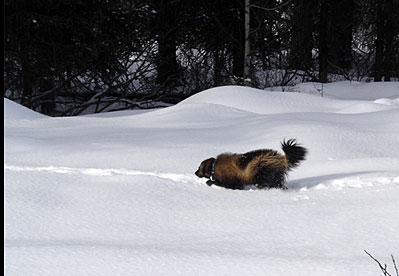
Wolverine release: This wolverine was collared and had just recovered from the immobilizing drug.
The wolverine'southward reputation precedes it.
In Mark Trail's Book of Animals, Ed Dodd writes: "Savage ferocity combined with mischievous cunning has made the wolverine an object of detest and dread among trappers."
In Mammals of N America, Vic Cahalane recounts the legendary prowess of the wolverine as fact: immensely stiff and known to drive bears and mount lions off their kills (two or three at a fourth dimension, even); capable of taking down a bear in a fight; and bad-tempered loners that will destroy a motel out of sheer deviltry.
Fact and Fiction
Fish and Game researchers Howard Golden and Mike Harrington are studying wolverines in South-central Alaska. In recent years they've captured 18 wolverines and equipped them with GPS tracking collars to better understand their movements and numbers. Wolverines are impressive, but much of the reputation is exaggerated.
"They've got such a bad rap," Harrington said. "I've had people ask, 'will they chase you downwards? Aren't they dangerous?' People wonder if we're afraid of them."
"A lot of myths about them are manner overblown," Gilded said. "People attribute magic powers to them, but they're only doing their thing, looking for food. They are curious, smart animals and they figure stuff out pretty quick. They are smart enough to run downwards a trap line, and that'll make trappers mad. Only it makes sense that they'd do that – at that place'south always food on these trap lines. They're not extra aggressive, they avert problem."
Wolverines are weasels, Golden said, and have the weasel nature. "That whole family is pretty similar, just the size is different. Ermine can be bold; weasels are an intelligent family unit of animals and they know how to survive."
While wolverines are commonly alone, the "bad tempered loner" stereotype gives the impression they are downright antisocial. Golden visited a facility in Washington that's dwelling house to most 40 wolverines. They shared a large common area and he said they were quite tolerant and social with each other.
"If resources are limited that tin can crusade conflict, merely they can be social," Gilt said. "If food is plentiful, they've got no reason to worry about each other. We've seen them in April from the air wrestling and playing with each other, they weren't fighting, they're socializing."
They are territorial, in the general sense of the give-and-take, merely Harrington and Golden use the term "home use area" to describe the expanse they favor. "They pick areas they maintain and proceed to themselves, males volition overlap with females, only males don't overlap much with males, or females with females," Harrington said. "They demand resource, and they pick an surface area where they tin brand a living and survive."
They have smell glands, a ventral gland near the omphalos, anal glands, and they besides accept picayune odour glands on the bottom of the pads of their feet, and when they walk they get out odour. They as well odour-mark through urination. "They basically maintain territory this mode through agile marking," Gilded said. "We accept found some that have been in fights and are scarred up, they practise become into tussles. "
He said a wolverine tin can defend itself pretty well, just it's no match for larger predators. "Two wolves can kill 1," he said. "You hear stories about them chasing bears off, I've never seen that happen, or known anyone who has."
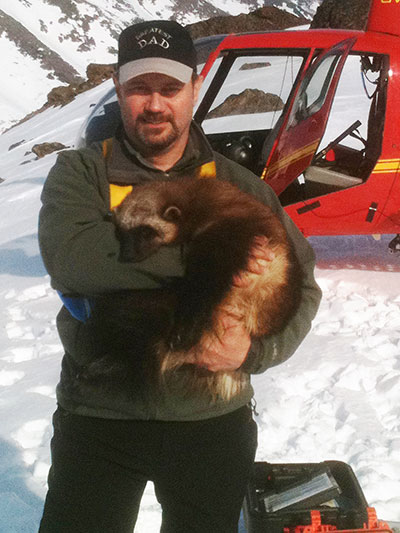
Mike Harrington holds a young female wolverine. Wolverines are sexually dimorphic; males are near thirty percent larger than females - 30 to twoscore pounds compared to females in the xx to 25 pound range. This female, CWF006 has a blue ear tag and was meaning when she was caught on March 7, 2012. In this movie she had just been recaptured to think her collar and is about to be released.
Their eyesight and hearing are not especially good, but they have an outstanding sense of smell.
"They've got a pretty good gear up of tools on them; a really skilful nose, they can smell food over long distances or buried well under the snow," Gilded said. "They tin climb trees. They accept a really warm coat. They've got strong claws for digging and defence, and incredibly strong jaws for bitter and crushing os and frozen meat - non the same crushing power as a wolf, only they're not equally big, a big wolverine is 40 pounds and modest wolf is sixty pounds."
"You look at them, they're mostly congenital for scavenging," Gold said. "Merely they're very opportunistic and regularly kill small game. They're non every bit fast as wolves, and they don't work in packs, simply they tin can be more predator than scavenger if the situation allows for it."
Wolverines chase snowshoe hares and voles, and in summer ground squirrels and marmots are of import casualty items. "We've got documentation of them killing smaller Dall sheep. In Scandinavian countries they lose domestic sheep and reindeer to wolverines, and the regime provides compensation to herders. The herders are required to hire rangers to document wolverine den sites and reproduction, and that's one reason they take corking reproductive information."
It is true that wolverines are very strong for their size and have incredible stamina. Golden said a wolverine can cover 30 miles in a dark, working a excursion in search of food. They will den up and remainder for brief periods, and then become back on the move. That ability to travel through incredibly rugged mountainous terrain is not exaggerated.
"That'southward the big thing to come out of the GPS work for Mike and I, and it'south pretty amazing when you lot come across it," Golden said. "We go locations every 20 minutes, you tin can run into how fast they move around terrain, they go up and downwards really steep, icy, rocky slopes like they're not even there. You could never hike it – you'd demand climbing gear. It'south like they come across the world every bit two-dimensional, the way they move up and down these snow-covered slopes."
Tracks in the snow
An innovative technique to assess population size has partly driven the research. ADF&G biometrician Earl Becker adult a method to estimate wolf populations based on aerial surveys of tracks in snow. Chosen SUPE, Sample Unit of measurement Probability Reckoner, Becker worked out the technique for wolves and he worked with Golden and Harrington to utilise it to wolverines. Given some bones assumptions, it works like this: biologists survey an surface area after fresh snowfall and identify sets of tracks. The track lines can be extrapolated to population numbers. Some bones assumptions must be met, for instance, all animals of interest move during the report, tracks are continuous, they're recognizable from the air, and pre and post snowstorm tracks can exist distinguished.
Wolverines behave differently from wolves, and they don't run in packs. An important divergence is that a wolverine may sometimes sit down tight for two or three days, in a den site or on a kill, and that needs to be factored in.
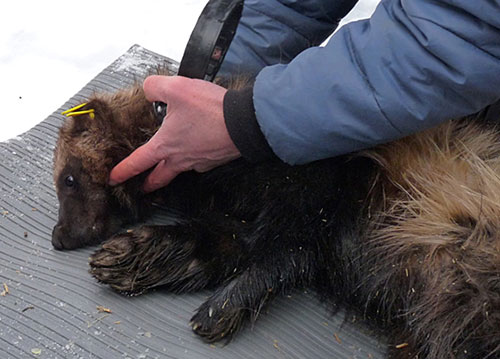
Howard Aureate fits a collar on a captured wolverine. Photograph past Isabelle Thibault.
"For 2 or three days out of 20 they might not be moving, and if we did a SUPE at that fourth dimension nosotros might miss 10 or fifteen percent that weren't moving after a fresh snowfall," Gilt said. "That'south a correction factor we need to utilize to the calculated estimate."
"The other matter virtually SUPE, information technology only works in some areas," he added. "It wouldn't work in Southeast; the canopy cover is besides thick. You accept to meet that ready of assumptions, and commonly nosotros can verify them while we're flying."
Collaring and tracking wolverines immune researchers to basis truth the technique – and learn a lot well-nigh wolverines in the process. Results from a cooperative study with Chugach National Forest indicated a wolverine density of four.5 to v.0 wolverines per 1,000 foursquare kilometers in Kenai Mountains and Turnagain Arm surface area, which is typical for other areas of South-fundamental where SUPES were conducted.
"Dissimilar techniques are suitable for sure areas," Golden said. "In some areas you lot're but looking for occupancy – exercise we even have wolverines?"
The researchers pointed out ii other methods used to study wolverines. Pilus snares subtly snag a tuft of fur from a passing animal, and the Dna in the follicles enables biologists to identify private animals, their gender and relatedness, and multiple samples over time can provide a population approximate (mark-recapture). Photo identification uses remote, move-triggered trail cameras to photograph animals in specific poses that reveal distinctive markings that tin can identify individuals – much equally tail fluke marks are used to identify humpback whales.
Catching wolverines: traps and darts
The researchers captured 18 different wolverines betwixt September 2007 and March 2014. Including recaptures, animals were live-trapped xiv times and helicopter-darted 10 times. Amidst the xviii wolverines captured, there were 5 juvenile (1–2 years quondam) females, five adult females, four juvenile males and four developed males. Wolverines were captured in the Chugach Mountains due east of Anchorage (in the country park), on the Elmendorf-Richardson articulation base (JBER) and southward of Anchorage in the Kenai Mountains. The capture piece of work was done in cooperation with Chugach State Park, JBER Natural Resources Department, and Chugach National Forest.
Three wolverines did non yield data – they slipped their collars right away, or for some other reasons researchers were unable to find signals. All the telemetry work was washed in late winter and early on spring to ameliorate understand how wolverines move during the period when SUPES are conducted.
Cameras proved to be a valuable tool for trapping and darting. Motion-triggered trail cameras were set upwards near the live traps, and researchers wore helmet-mounted video cameras when helicopter darting to help them learn from capture attempts. That helped them solve an equipment malfunction at one point in the project - they slowed the video downwards and watched it frame by frame, revealing a problem with the sprint design they were able to correct.
Darting can be really efficient under ideal weather, and Aureate said one day they caught 4 wolverines. That was infrequent, some days they found wolverines they couldn't catch. Aircraft searched for roaming wolverines, and and so called the capture team.
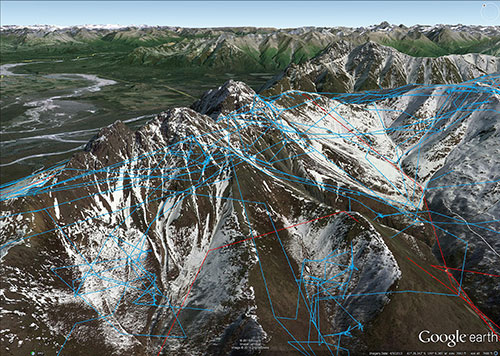
This Google Globe 3D map shows the movements of two wolverines through the upper slopes and summits of the rugged Chugach Mountains. CWM006 is a male, and the red line shows his movements over about a calendar month, between his capture and collaring February. 21, 2013 and his final transmission March 26, 2013. The blue line shows the movements of CWF008, a female captured March 2, 2013 and her last transmission June 12, 2013, about a iii-month period. "This is how they really work in the three-dimensional world," Harrington said. "Y'all really get a good appreciation when you see how steep it is and how they go upward and down that rugged stuff."
"Wolverines are never very abundant, fifty-fifty when they're abundant for the species," Golden said. "Yous need good weather to rail them, we had 2 fixed-wing shipping just looking for animals, sometimes for hours, and and then we're sitting on a ridge with the helicopter, waiting. Then we get the phone call and become later them."
Darting a moving animate being from a moving helicopter is clearly a claiming. Harrington said the mountainous terrain and relatively small size of the target added to the difficulty. One thing played to their advantage, he said when pursued, wolverines tended to run uphill. In deep snow that actually hampered their speed.
"On difficult packed snow, we couldn't believe how fast they can run," he said.
Pursuit was limited to 10 minutes. "Sometimes we had to say, 'we're not going to get this guy.'"
Once caught, wolverines were quickly candy. Throughout processing biologists monitored wolverines' temperature, middle rate and respiration, and were prepared to provide supplemental oxygen if needed. They took samples of tissue (for Dna), pilus and claret, the animals were weighed and measured, age estimated, and they were marked with an ear tag and equipped with a GPS/VHF neckband.
The collars were programmed to record GPS locations at 20-min intervals, and were capable of maintaining that charge per unit of information drove for about 3 months and so to continue VHF beaconing for nearly 100 days longer before battery failure. Collars also stored distance and air temperature. Two types of GPS collars were used; both stored thousands of location information points onboard and immune remote downloading of collar data from the ground or from the air. One model could be released remotely to driblet-off, the other could not and required recapture to retrieve collars.
Golden and Harrington were successful live-trapping on JBER during the showtime two or 3 years while new animals were still coming into the trapsites. The researchers took advantage of a wintertime moose hunting season on the joint base of operations - wolverines were attracted to kill sites and worked the hunt areas into their foraging circuits. However, it became very difficult to attract wolverines into traps during winter of 2012–xiii, which they attributed mostly to the lack of new wolverines visiting the area. From images gathered on the remote cameras, it seemed the animals were besides wary to be caught.
"They remember where they've institute food, but they got wise to the traps really quick," Harrington said. "They're hard to live trap in the showtime identify, and really hard after that. Yous might fool them one time, only how do yous fool them again after that? Nosotros got creative with different kinds of bait - we tried chickens wrapped in bacon, and large wads of beefiness suet."
Wide ranging
Home range estimates for wolverines in South-central Alaska bear witness females use about 300 to 600 foursquare kilometers (115-230 square miles) and males use about 700 to 1,000 square kilometers (270 to 380 foursquare miles.
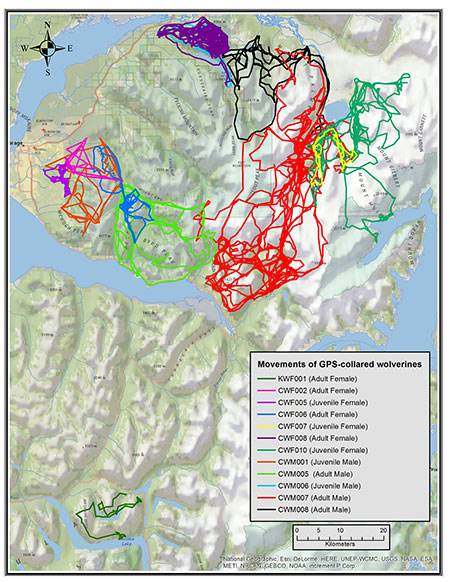
Movements of 11 wolverines in the Chugach Mountains east of Anchorage, and one wolverine on the Kenai Peninsula farther due south. Turnagain Arm is the water in the heart left. Developed male person CWM007 is depicted in crimson and has a home employ area twice the size of other wolverines. Note the movements of the male person (CWM006) and female (CWF008) as shown on the other map of the mount tops.
Males and females traveled extensively throughout their home use areas. Both sexes occasionally went on exploratory trips and then returned to their chief areas. A wait at the movements of 5 wolverines over the course of a yr (two females and iii males) showed groovy variation in distances traveled, some days they covered a lot of ground, others days non and then much. The average distances traveled per 24-hour interval was nigh 12 kilometers for the females, and between eight and 21 kilometers for the males.
"One male person had twice as large an area as other wolverines," Golden said. "It may be that area had lost a male person and this brute simply took over the whole area, at least for the short time the collar was agile."
Because the focus of the study was movement in belatedly winter and spring, the researchers did not runway wolverines year-circular. The far ranging male did provide some information in tardily bound – when he expanded his range even more than.
"They practise spend a lot of time in summer during the breeding season testing boundaries and trying to see females," he said.
An important time in a wolverine's life, and a time for meaning movement, is when a young adult strikes out to establish its own abode range. Wolverines are born in February or March, two to 4 kits that usually dwindle from mortality to one or two by autumn.
"Bloodshed is pretty high for kits," Golden said. "We're finding females mostly don't have a litter before they're about three years old, and so typically have a litter almost every other year."
The kits are essentially total grown by Oct or Nov and begin moving out. It can be tough for a young wolverine to find a territory that is unoccupied and suitable. "A daughter might stay with mom a couple years and inherit her surface area," Aureate said. "Young may try and stay relatively close to their natal area, and siblings may be more tolerant of each other."
Just wolverines have been known to disperse equally far as 235 miles. Dispersal is important, that's how wild areas that "produce" wolverines can supply them to potential home ranges elsewhere, good habitat where wolverines may have been harvested.
That balance is a model for sustainable yield – enough refugia from human being activity, good habitat for wolverines that are producing young that will emigrate out.
Hunters and trappers in Alaska harvest near 550 wolverines each year. Because wolverine reproductive potential and survivorship is low information technology's important to empathise where and when animals are harvested to exist certain the population is not overharvested. Wolverines disperse depending on availability of nutrient and habitat resource, and animals dispersing from areas where they are not trapped replenish the population in areas where they are hunted and trapped.
A gallery of trail photographic camera photos of wolverines is bachelor, as well as a short video of a wolverine raiding the nest of a ground-nesting shorebird and eating the eggs.
Riley Woodford is the editor of Alaska Fish and Wild animals News.
Receive a monthly notice about new problems and articles.
Source: https://www.adfg.alaska.gov/index.cfm?adfg=wildlifenews.view_article&articles_id=692
0 Response to "How Many Babies Does a Wolverine Have Wolf"
Post a Comment